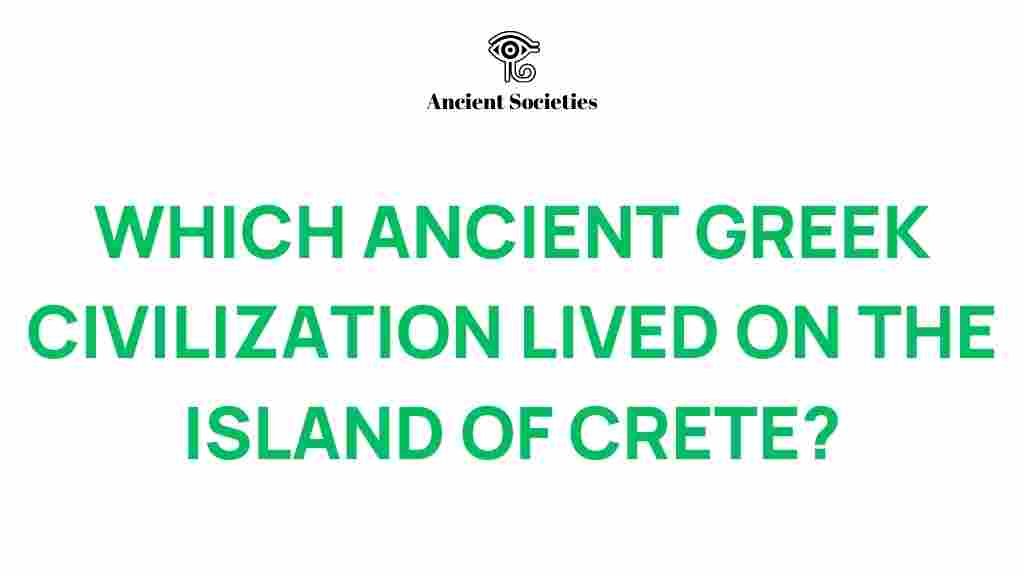Minoan Civilization: Unveiling the Mysteries of the Ancient Minoan Civilization
The Minoan civilization, often regarded as one of the earliest advanced societies in Europe, flourished on the island of Crete during the Aegean Bronze Age, roughly between 2700 and 1450 BCE. This remarkable civilization is renowned for its unique culture, sophisticated architecture, and significant contributions to the history of ancient Greece. As archaeologists continue to unearth artifacts and explore the ancient palaces, such as the famous Palace of Knossos, the mysteries surrounding the Minoan civilization become increasingly intriguing.
The Origins of the Minoan Civilization
The origins of the Minoan civilization can be traced back to the Neolithic period, but it was during the Bronze Age that it reached its zenith. The civilization is named after the legendary King Minos, who, according to mythology, ruled over Crete and was associated with the labyrinth and the Minotaur. The Minoans are believed to have been a seafaring people, engaging in trade across the Aegean Sea and beyond, which contributed to their wealth and cultural exchange.
Geographical Significance of Crete
Located strategically in the Aegean Sea, Crete served as a crucial maritime hub that connected various ancient cultures, including Egyptian, Mesopotamian, and later, Greek civilizations. This central location allowed the Minoans to establish extensive trade networks, facilitating the exchange of goods, ideas, and cultural practices.
Archaeological Discoveries and Artifacts
Archaeology has played a vital role in uncovering the rich history and culture of the Minoan civilization. Excavations on Crete, particularly at the Palace of Knossos, have yielded numerous artifacts that provide insights into their daily life, religious practices, and artistic achievements.
- Pottery: Minoan pottery is known for its intricate designs and vibrant colors, showcasing scenes from nature and mythology.
- Frescoes: The colorful frescoes found in the Palace of Knossos depict various aspects of Minoan life, including religious rituals, sports, and natural landscapes.
- Linear A Script: The Minoans developed a writing system known as Linear A, which remains undeciphered but is believed to have been used for administrative purposes.
The Palace of Knossos: A Architectural Marvel
The Palace of Knossos is perhaps the most significant archaeological site related to the Minoan civilization. Discovered by Sir Arthur Evans in the early 20th century, the palace complex covers over 20,000 square meters and includes numerous rooms, storage facilities, and grand staircases. Its sophisticated layout is a testament to Minoan architectural prowess.
Key features of the Palace of Knossos include:
- Multi-story Buildings: The palace was constructed with multiple levels, showcasing advanced engineering techniques.
- Throne Room: The throne room, adorned with frescoes and a stone throne, is believed to have been a center for religious and political activities.
- Complex Plumbing System: The Minoans had an intricate plumbing system that included bathrooms and drainage, highlighting their advanced understanding of sanitation.
Culture and Society of the Minoans
The Minoan civilization was characterized by a rich cultural tapestry. Their society was likely matriarchal, as evidenced by the prominence of female deities in their religious practices. The worship of goddesses associated with fertility and nature played a crucial role in Minoan spirituality.
Some aspects of Minoan culture include:
- Religious Practices: The Minoans practiced polytheism, worshiping a variety of deities, and rituals often took place in sacred caves and palaces.
- Art and Craftsmanship: Minoan art is distinguished by its naturalistic style, with depictions of animals, plants, and human figures, often conveying movement and emotion.
- Sports and Games: The Minoans engaged in various sports, including bull-leaping, a perilous activity that symbolized bravery and skill.
The Decline of the Minoan Civilization
The decline of the Minoan civilization is still a topic of debate among historians and archaeologists. Several theories have been proposed, including:
- Natural Disasters: The eruption of the Santorini volcano around 1600 BCE is believed to have caused widespread destruction and tsunamis that affected Crete.
- Invasion by Mycenaeans: The rise of the Mycenaean civilization on mainland Greece may have led to military conflicts and eventual takeover of Minoan territories.
- Economic Decline: Changes in trade routes and economic conditions could have weakened the Minoan economy, contributing to their decline.
Archaeology and the Study of Minoan Civilization
Modern archaeology continues to reveal new insights into the Minoan civilization. Ongoing excavations and advanced technologies, such as ground-penetrating radar, are uncovering more artifacts and structures that help researchers piece together the history and culture of this enigmatic society.
For those interested in the Minoan civilization, visiting archaeological sites in Crete provides an immersive experience. Some key sites to explore include:
- Palace of Knossos: The largest and most famous Minoan site, showcasing the grandeur of Minoan architecture and art.
- Phaistos: Another significant palace complex that offers insights into Minoan society and culture.
- Heraklion Archaeological Museum: Home to a vast collection of Minoan artifacts, including pottery, frescoes, and tools.
Conclusion: The Legacy of the Minoan Civilization
The Minoan civilization remains a captivating subject of study, with its rich history, vibrant culture, and significant contributions to ancient Greece. Through ongoing archaeological efforts, we continue to unveil the mysteries of this remarkable society that thrived on the island of Crete. The artifacts and architectural wonders left behind serve as a testament to the ingenuity and creativity of the Minoans, influencing future generations and leaving an indelible mark on the history of the Aegean Sea.
As we delve deeper into their history, we not only gain a better understanding of the Minoans but also appreciate the interconnectedness of ancient civilizations. To learn more about the Minoan civilization and its impact on history, visit this detailed resource that explores their legacy.
For further exploration of archaeological findings in ancient Greece, check out this comprehensive guide that covers various civilizations and their contributions to history.
This article is in the category Archaeology and created by AncientSocieties Team

2 thoughts on “Unveiling the Mysteries of the Ancient Minoan Civilization”